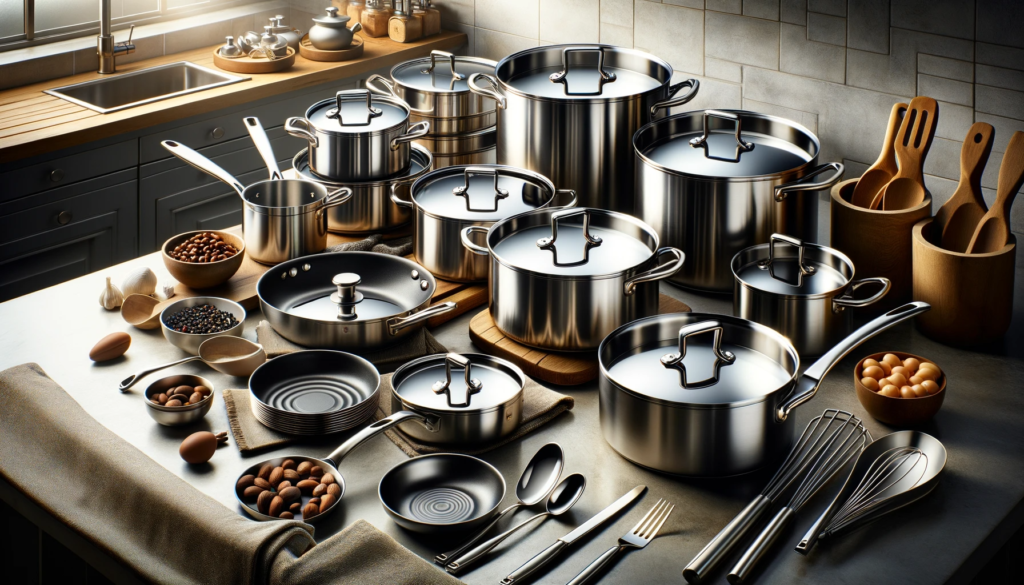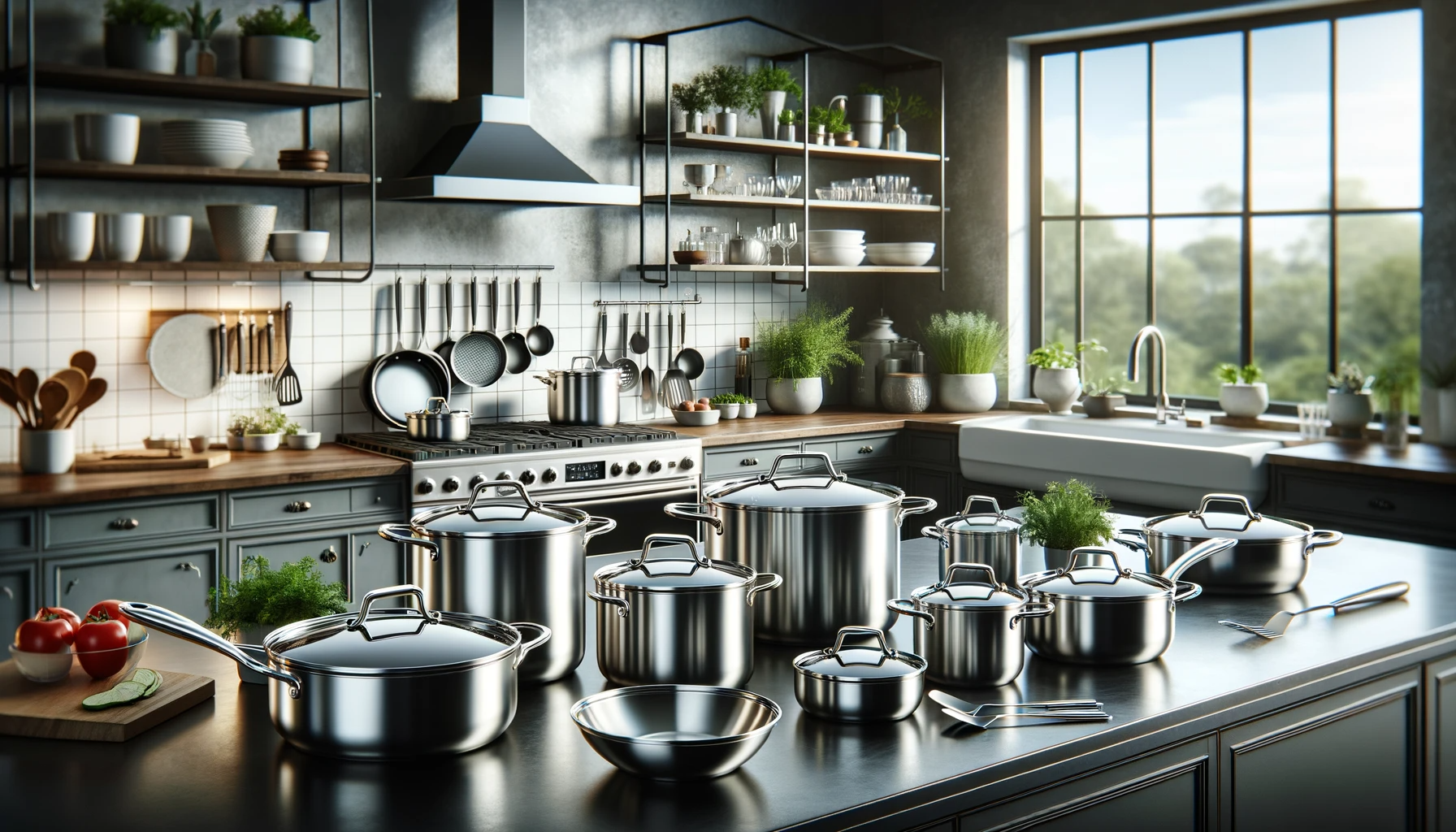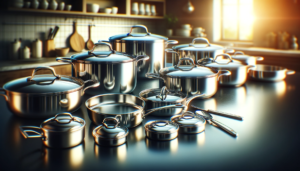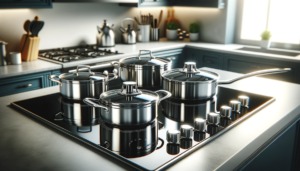With so many cookware options lining store shelves, distinguishing quality comes down to understanding materials.
When safety and versatility matter most in the kitchen, food grade stainless steel emerges as the gold standard.
Food grade stainless steel’s inert, steady heating makes it unmatched for cooking performance and durability compared to other metals and coatings.
To leverage stainless steel’s capabilities fully, let’s examine what defines it as food grade and survey its advantageous properties manifest in pots, pans and more.
What is Food Grade Stainless Steel?

Food grade stainless steel refers to any stainless steel alloy that is safe for food contact and meets certain regulations that designate it as such.
Stainless steel contains alloys including chromium, nickel, manganese and carbon.
The most common grades used for food contact applications are 304 and 316 stainless steel.
These steels contain enough chromium to provide corrosion resistance when exposed to oxygen.
The “food grade” designation means that the stainless steel has met guidelines showing it does not allow the leaching of dangerous metals into food under normal usage.
This makes it ideal for manufacturing pots, pans, mixing bowls and other kitchenware utilized for cooking.
Food grade stainless steel resists corrosion and oxidation under the conditions of a normal kitchen environment.
Benefits of Using Food Grade Stainless Steel Cookware

Stainless steel cookware offers many advantages that make it a popular choice for serious home cooks as well as professional chefs.
Using food grade stainless steel ensures safety, as it does not leach potentially harmful chemicals from the metal into food during the cooking process.
This chemically inert property also allows stainless steel to withstand very high heat without warping or breaking down.
The material is also non-porous and easy to clean thoroughly to prevent the spread of bacteria.
Additional characteristics such as durability, oven and dishwasher safe use, resistance to acidic foods such as tomatoes, affordability and an attractive appearance solidify stainless steel’s reputation as a versatile, low maintenance option suitable for almost any cooking application.
While conductivity may be higher in metals like copper and aluminum, the balance of useful traits in food grade stainless steel establishes it as a practical material for cooks wanting reliable cookware across a spectrum of techniques.
Types of Food Grade Stainless Steel Cookware

The category of stainless steel cookware encompasses a wide array of pot, pan and baking vessel styles constructed out of food grade metal alloys.
From basic essential pots and pans for boiling, frying and sauce making to specialized items like stock pots, sauté pans and cookie sheets, stainless steel dominates the cookware manufacturing industry.
Pots and pans represent some of the most universally utilized stainless kitchen vessels.
Sauce pots, sauteuses, stock pots and frying pans provide foundational cooking functionality leaning on the strengths of stainless – even heating, easy deglazing, boil over and corrosion resistance and non-reactive baking and simmering.
Stock pots leverage taller sides to facilitate boiling noodles, making broths and stocks and preparing large batches of soups or stews.
Sauté pans offer classic sloped sides to simplify tossing and flipping ingredients via quick wrist motions.
Skillets excel at quick cooking techniques like pan frying as stainless steel distributes heat evenly across the cooking surface.
Bakeware like stainless steel cookie sheets, cake pans and muffin tins all take advantage of steel’s balanced heat conduction and avoidance of hot spots.
Mixing and serving bowls are a stainless steel kitchen staple as well, transferring from prep to table seamlessly.
Factors to Consider When Purchasing

Several considerations factor into choosing the optimal stainless steel cookware set or piece to match cooking requirements and budget.
Weight and thickness impact heating responsiveness – thinner pots and pans react quicker while heavier ones resist warping.
Copper cores boost conductivity in tri-ply models but come at increased costs.
Riveted handles stay cooler while welded handles blend more seamlessly into cookware aesthetics.
Purchasers should check oven-safe recommendations to confirm temperatures and times pieces can withstand without risk of damage.
Those intending to use pans under the broiler should seek out upgraded heat resistance specifications.
Some manufacturers boost performance through clad construction or proprietary treatments to steel which improves capabilities.
Comparison shopping warranties provides peace of mind against defects in materials or workmanship.
While stainless steel stands up well to daily wear and tear over decades, faults can occur.
And if cookware fails to live up to expectations, reasonable return policies offer flexibility.
Proper Care and Maintenance

While stainless steel withstands heavy usage, proper care optimizes longevity and performance.
Hand washing pans instead of dishwashing prevents microscopic nicks to finished surfaces over time.
Avoiding metal utensils further protects finishes.
While durable, stainless can scratch from salt, coarse scrubbing pads and abrasives.
Non-abrasive cleaners safely remove cooked on residue.
Pans should not be allowed to overheat while empty during preheating.
Internal damage and exterior discoloration can result without contents to absorb the heat.
Likewise leaving empty cookware over high heat can cause food debris to burn onto the surface.
After cooking, immediately deglazing while hot facilitates cleaning.
Proper storage that avoids scratches and dents to finishes enhances appearance and resale value.
Comparison to Other Cookware
Stainless steel complies with food safety excluding coatings that can chip or degrade over time.
PTFE/Teflon non-stick coatings offer temporary release properties but wear away exposing underlying metal.
Ceramic coatings increase scratch resistance but still carry durability limitations.
Uncoated stainless steel requires more oil for release during cooking but sears and browns exceptionally.
Aluminum and copper offer excellent conductivity compared to steel but react strongly to acidic ingredients like tomatoes or vinegar.
Reactive metals can impart metallic tastes as well as discoloration.
Stainless contains enough chromium to resist reactivity through passivation while still heating relatively evenly.
Cast iron and carbon steel pans traditional non-stick performance due to seasoning developed over time.
But both materials exhibit hot spots on cooking surfaces leading to inconsistent results.
Stainless steel equals or bests conductivity vs carbon steel with a more uniform heating pattern.
1. Weight and Thickness
Heavier gauge stainless steel pans absorb heat more slowly but retain it exceptionally well to improve temperature regulation and avoid drastic spikes.
Thicker cookware tends not to warp even under extreme thermal loads.
Thinner stainless steel reacts more quickly offering nimble, responsive performance.
Professional chefs often prefer responsive thinner pans for techniques like tossing sauces or sautéing.
Home cooks gravitating toward more delicate cooking may also favor responsiveness over heat retention.
Copper cores help bridge the gap through better conductivity.
But solid stainless steel still lands in the middle offering a balance of moderate heat-up times with steady, even temperature maintenance that excelles particularly at simmering and baking applications.
2. Whether There is a Copper Core
Copper boosts thermal conductivity substantially above stainless steel.
But copper reacts strongly with some foods.
To get the best of both metals, manufacturers fuse copper cores between two layers of stainless steel creating tri-ply cookware.
The steel encapsulates the copper neutralizing reactivity while the copper improves heat flow into the pan for quick reaction and controlled regulation.
5-ply cookware adds intermediate aluminum layers further multiplying heat transfer making it well suited for very precise cooking requirements.
The more exotic combinations do come at a cost though, sometimes 4-5 times basic stainless steel.
For most home kitchens, good ‘ol single layer stainless distributes heat evenly enough for great daily performance across a spectrum of techniques.
3. Riveted Handles vs Welded Handles
Handle construction plays a role in performance, safety and aesthetics.
Welded handles meld seamlessly into pans for a clean, streamlines look many prefer.
But the thinner joinery where handles meet the cooking surface transmit more heat making them harder to grasp when hot.
Welds also represent potential failure points long term.
Rivets offer both strengths and drawbacks.
Visible mechanical fasteners disrupt visually sleek profiles but the isolation from direct contact with cooking surfaces keeps handles significantly cooler to grab safely.
Rivets also withstand years of stress and use overall preserving structural integrity.
Home cooks choosing between welded vs riveted handles ultimately balance visual priorities against functionality.
Welded transitions smoothly while rivets remain safely cool when cooking.
Performance wise either option holds up well in food grade stainless steel cookware.
4. Oven-Safe Temperatures
Quality stainless steel cookware withstands the demands of full oven exposure beyond just stovetop cooking.
Manufacturers specify maximum usage temperatures which buyers should confirm meet their requirements.
Less expensive stainless steel pans may rate around 300-375°F before risking structural issues.
Higher grade examples safely handle broiler exposure nearing 500°F.
If intending to use pans for uncovered high heat roasting or broiling look for rated oven safe temperatures exceeding your typical recipe needs.
Opting for multipurpose stainless steel ovensafe cookware enables transferring dishes seamlessly from burners or cooktops directly into hot ovens.
Checks specs before purchases to prevent unexpected damages down the road.
5. Warranties Against Defects
Reputable stainless steel cookware companies back their products against defects in materials and workmanship which shouldn’t occur in normal household use.
More expensive product lines typically extend longer coverage periods although warranties range widely from a few months up to the lifetime of a product.
Manufacturing faults happen even in durable stainless steel.
Confirming warranty terms provides peace of mind for customers investing significant amounts into quality pots and pans.
Make sure to follow all care and usage guidelines which often stipulate proper cleaning methods and forbid abrasives which can strip finishes.
Reasonable warranties demonstrate a company stands behind its cookware, promising to replace defunct items damaged through no fault of the owner given products are properly maintained.
Conclusion
In conclusion, food grade stainless steel represents an optimal material for cookware and bakeware.
Its corrosion resistant durability, non-reactive heating properties, ease of cleaning and broad oven/stovetop functionality posit stainless steel as an essential component of both household and professional kitchens.
While alternatives like non-stick coatings sacrifice longevity and uncoated reactive metals impose flavor limitations, stainless steel’s steadfast traits enable lifelong cooking performance across a spectrum of techniques.



